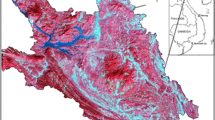Abstract
In the present study, forest type classification using Landsat TM False Colour Composite (FCC) bands 2, 3, 4 has been evaluated for mapping highly heterogeneous forest environment of Western Ghats (Kerala). Visual interpretation of Landsat TM FCC has been carried out to identify bioclimatic vegetation types. For accuracy estimation maps prepared from 1∶15,000 scale black-and-white aerial photographs have been used as ground check data. For comparison aerial photomap classes have been aggregated to match with Landsat-TM-derived map. The classification accuracy of ten major bioclimatic and landcover types was estimated using systematic sampling procedure. The overall classification accuracy of the forest types for the study area was 88.33%.
Similar content being viewed by others
References
Aronoff S (1982). Classification accuracy: A user approach.Photogrammetric Engineering and Remote Sensing, Vol. 48, No. 8, 1299–1307.
Champion H G and Seth S K (1968). A Revised Survey of Forest Types of India, Manager of Publications, New Delhi.
Congalton R, Oderwald R and Mead R (1983). Assessing Landsat Classification Accuracy Using Discrete Multivariate Analysis Statistical Technique.Photogrammetric Engineering and Remote Sensing, Vol. 49, No. 12, 1671–1678.
Hopkins Paul F, Maclean Ann L and Lillesand Thomas M (1988). Assessment of Thematic Mapper Imagery for Forestry Applications under Lake States Conditions.Photogrammetric Engineering and Remote Sensing, Vol. 54, No. 1, 61–68.
Hord R M and Brooner W (1976). Landuse Map Accuracy Criteria.Photogrammetric Engineering and Remote Sensing, Vol. 42, No. 5, 671–677.
Porwal M C and Pant D N (1989). Forest Cover Type and Landuse Mapping using Landsat Thematic Mapper False Colour Composite. A Case Study for Chakrata in Western Himalayas, U.P.Photonirvachak, Journal of Indian Society of Remote Sensing, Vol. 17, No. 1, 33–40.
Roy P S, Kaul R N, Roy M R and Gabryal S S (1985). Forest Type Stratification and Delineation of Shifting Cultivation in the Eastern Part of Arunachal Pradesh using Landsat MSS Data.International Journal of Remote Sensing, Vol. 6 (3 & 4), 411–418.
Roy P S, Ranganath B K, Diwakar P G, Vohra T P S, Bhan S K, Singh I J and Pandian V C (1991). Forest Type Mapping and Monitoring in Tropics using Remote Sensing.International Journal of Remote Sensing (in press).
Story Michael and Congalton Russel G (1986). Accuracy Assessment: A User’s Perspective.Photogrammetric Engineering and Remote Sensing, Vol. 52, No. 3, 397–399.
Tomar M S and Maslekar A R (1974). Aerial Photographs in Landuse and Forest Surveys, Dehradun, Jugal Kishore & Co.
Unni N V M, Roy P S and Parthasarathy V (1985). Evaluation of Landsat and Airborne Multispectral Data and Aerial Photographs for Mapping Forest Features and Phenomena in a Part of the Godavari Basin.International Journal of Remote Sensing, Vol. 6 (3 & 4), 419–431.
Author information
Authors and Affiliations
About this article
Cite this article
Porwal, M.C., Roy, P.S. Vegetation type discrimination on Landsat TM data in heterogeneous forested landscape of Western Ghats—Accuracy evaluation from large scale aerial photo maps. J Indian Soc Remote Sens 20, 21–33 (1992). https://doi.org/10.1007/BF02991882
Received:
Accepted:
Issue Date:
DOI: https://doi.org/10.1007/BF02991882




